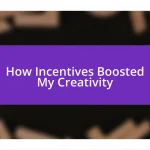Key takeaways:
- Incentives beyond monetary rewards, such as recognition and opportunities for collaboration, significantly enhance creativity and team dynamics.
- Common challenges in creative projects include misalignment of individual motivations with team goals, lack of clarity, and overemphasis on competition, which can stifle creativity.
- Evaluating the effectiveness of incentives requires qualitative feedback and consideration of team morale, highlighting the importance of emotional upliftment in fostering creativity.

Understanding Creative Project Incentives
When I first dived into creative projects, I quickly realized that incentives play a crucial role in my motivation. For instance, during a collaborative art installation, the excitement of seeing my work showcased alongside talented peers pushed me to explore new techniques and ideas. Isn’t it fascinating how a simple recognition can spark creativity and drive innovation?
I remember a project where we faced tight deadlines. The team decided to offer a small bonus for meeting early milestones, and it transformed the entire atmosphere. Suddenly, everyone was more energized and focused, turning what seemed like a daunting task into a joyful challenge. Have you ever noticed how a little encouragement can shift the dynamics of teamwork?
In my experience, the most effective incentives go beyond monetary rewards; they capture the essence of the creative spirit. For example, we often held brainstorming sessions that celebrated every contribution, which fostered an environment of collaboration and trust. Isn’t it true that when our contributions are valued, we’re more likely to push the envelope and take risks with our ideas?

Impact of Incentives on Creativity
The influence of incentives on creativity is quite profound. I recall one particularly challenging graphic design project where we introduced a “Creative Freedom Day.” This initiative allowed team members to explore wild ideas without the pressure of client constraints. It was exhilarating to watch how this liberation led to innovative concepts, proving that sometimes stepping away from conventional expectations can yield the most inspiring outcomes.
In another instance, during a marketing campaign brainstorming session, our leader offered the team a unique prize: dinner with a local artist. The idea sparked a competitive edge, but more importantly, it cultivated a sense of community and inspiration. Seeing how excited everyone was to connect their creative ideas with the potential for genuine collaboration made a tangible difference in our output. Has there ever been a moment in your work where the right incentive completely shifted your approach?
Reflecting on these experiences, I believe intrinsic incentives, such as personal growth and creative satisfaction, often outweigh monetary ones. When I worked on a community mural project, it wasn’t the small fee that motivated me; it was the chance to contribute to something meaningful. The atmosphere of collaboration and artistic exploration was electrifying, reminding me that true creativity thrives when we feel valued and connected.
| Type of Incentive | Impact on Creativity |
|---|---|
| Monetary Rewards | Can boost motivation temporarily but may not sustain long-term creative engagement. |
| Recognition and Celebration | Fosters a sense of belonging and encourages risk-taking in creative work. |
| Opportunities for Collaboration | Enhances idea generation and leads to innovative solutions through shared perspectives. |

Common Challenges with Creative Incentives
One of the common challenges I encountered with creative incentives was the potential for misalignment between individual motivations and team goals. I remember participating in a photography project where we initially set up incentives that focused heavily on individual achievements. While this approach sparked competition, it ended up creating tension within the team. Instead of collaborating, we felt compelled to outshine each other, which stifled the very creativity we aimed to boost. It’s a delicate balance to strike; sometimes building community is essential to creative success.
Here are some challenges I faced:
- Lack of Clarity: When goals aren’t clear, participants may focus on the wrong incentives, leading to frustration.
- Overemphasis on Competition: While a little competition can be motivating, too much can hinder collaboration and shared creativity.
- Inflexibility in Reward Systems: If incentives are rigid, they can exclude those whose contributions don’t fit the mold, diminishing overall engagement.
Another challenge I observed is that relying exclusively on financial incentives could dull creativity. I once joined a design challenge where there was a sizable cash prize, but as the deadline approached, I felt the pressure stifling my imagination. I found myself prioritizing what I thought would “win” over exploring my genuine creative ideas. That experience taught me that incentives need to align with the creative process rather than impose external restrictions. In this sense, it’s important to remember that creativity thrives in environments that nurture exploration and authenticity.

Evaluating Incentive Effectiveness in Projects
Evaluating the effectiveness of incentives in creative projects can be quite subjective. I remember a project where we implemented feedback sessions as an incentive. Initially, I thought this would simply be a formality. However, as I participated, I truly felt my voice mattered. The experience shifted my perspective. Could it be that the right kind of recognition transforms how we perceive our contributions?
When assessing how well incentives worked, I often looked back at team morale. I worked on a collaborative design initiative that offered team outings as a reward for meeting creative milestones. At first, I was skeptical. But seeing everyone energized, brainstorming ideas during those outings, was enlightening. It reminded me that sometimes, the best incentives aren’t tangible rewards but memorable shared experiences. Isn’t it fascinating how group dynamics can elevate individual creativity?
In my experience, qualitative feedback is crucial in evaluating incentive effectiveness. A creative writing workshop I attended once introduced peer reviews as part of their incentive system. Initially reluctant, I found receiving thoughtful critiques to be incredibly motivating. It made me delve deeper into my writing, transforming what could have been a mundane task into a rich learning experience. This revealed to me that understanding participant sentiments is just as important as monitoring results; after all, isn’t it the emotional upliftment that truly drives creative inspiration?














